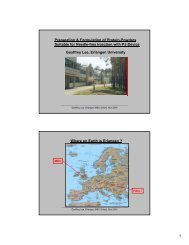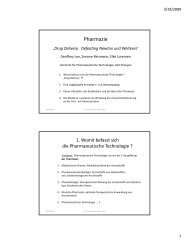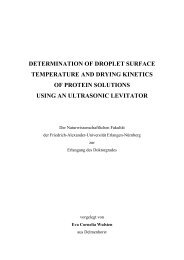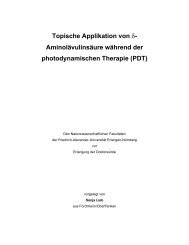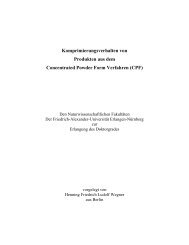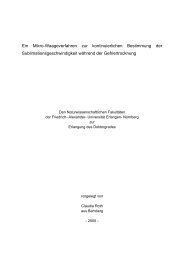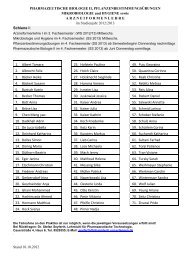- Page 1: REGULATING PARTICLE MORPHOLOGY DURI
- Page 4 and 5: IIFür meinen Großvater
- Page 6 and 7: IVPetra Neubarth danke ich für die
- Page 8 and 9: VIParts of this thesis have already
- Page 10 and 11: IITABLE OF CONTENTS4 MATERIAL AND M
- Page 12 and 13: IVTABLE OF CONTENTS5.4 Lactate Dehy
- Page 14 and 15: VIABBREVIATIONSSmall lettersaacd pi
- Page 16 and 17: VIIIABBREVIATIONSSEMSFDSFLSLSSSAUVs
- Page 18 and 19: 2 INTRODUCTIONdrying (SFD) [Maa et
- Page 20 and 21: 4 INTRODUCTION TO SPRAY FREEZE‐DR
- Page 22 and 23: 6 INTRODUCTION TO SPRAY FREEZE‐DR
- Page 24 and 25: 8 INTRODUCTION TO SPRAY FREEZE‐DR
- Page 26 and 27: 10 INTRODUCTION TO SPRAY FREEZE‐D
- Page 28 and 29: 12 INTRODUCTION TO SPRAY FREEZE‐D
- Page 30 and 31: 14 INTRODUCTION TO SPRAY FREEZE‐D
- Page 32 and 33: 16 INTRODUCTION TO SPRAY FREEZE‐D
- Page 36 and 37: 20 LIGHT‐SCATTERINGWhen an electr
- Page 38 and 39: 22 LIGHT‐SCATTERINGThe dominant p
- Page 40 and 41: 24 LIGHT‐SCATTERING3.2.2 The spec
- Page 42 and 43: 26LIGHT‐SCATTERINGa)b)Figure 13.
- Page 44 and 45: 28 LIGHT‐SCATTERINGassure correct
- Page 46 and 47: 30 LIGHT‐SCATTERINGThe positions
- Page 48 and 49: 32LIGHT‐SCATTERING3.3.1Size exclu
- Page 50 and 51: 34 LIGHT‐SCATTERINGthe permeable
- Page 52 and 53: 36 MATERIAL AND METHODS4.1.1.1 Bovi
- Page 54 and 55: 38 MATERIAL AND METHODS[1983] defin
- Page 56 and 57: 40 MATERIAL AND METHODSthe molecule
- Page 58 and 59: 42MATERIAL AND METHODS4.2Methods4.2
- Page 60 and 61: 44 MATERIAL AND METHODS4.2.2 Spray
- Page 62 and 63: 46 MATERIAL AND METHODSupstream of
- Page 64 and 65: 48 MATERIAL AND METHODS348 nm at 25
- Page 66 and 67: 50 MATERIAL AND METHODSblank titrat
- Page 68 and 69: 52 MATERIAL AND METHODS50 mM trizma
- Page 70 and 71: 54 RESULTS AND DISCUSSIONAfter all
- Page 72 and 73: 56 RESULTS AND DISCUSSIONAs a small
- Page 74 and 75: 58 RESULTS AND DISCUSSIONWhen calcu
- Page 76 and 77: 60 RESULTS AND DISCUSSIONcalibratio
- Page 78 and 79: 62 RESULTS AND DISCUSSION5.1.3 UV
- Page 80 and 81: 64 RESULTS AND DISCUSSIONFigure 41.
- Page 82 and 83: 66 RESULTS AND DISCUSSIONAn advanta
- Page 84 and 85:
68 RESULTS AND DISCUSSION5.1.6 Dete
- Page 86 and 87:
70 RESULTS AND DISCUSSIONa)b)Figure
- Page 88 and 89:
72 RESULTS AND DISCUSSIONIn additio
- Page 90 and 91:
74 RESULTS AND DISCUSSIONa) b)Figur
- Page 92 and 93:
76 RESULTS AND DISCUSSION5.1.9 Solv
- Page 94 and 95:
78 RESULTS AND DISCUSSIONthat could
- Page 96 and 97:
80 RESULTS AND DISCUSSION5.1.10 Eva
- Page 98 and 99:
82 RESULTS AND DISCUSSION5.2 Bovine
- Page 100 and 101:
84 RESULTS AND DISCUSSIONFigure 57.
- Page 102 and 103:
486 RESULTS AND DISCUSSIONFigure 59
- Page 104 and 105:
88RESULTS AND DISCUSSIONFigure 62.
- Page 106 and 107:
90 RESULTS AND DISCUSSIONFigure 65.
- Page 108 and 109:
92 RESULTS AND DISCUSSIONa) b)Figur
- Page 110 and 111:
94 RESULTS AND DISCUSSION5.3 SFD/SD
- Page 112 and 113:
96 RESULTS AND DISCUSSIONactivity l
- Page 114 and 115:
98 RESULTS AND DISCUSSION[Maa and P
- Page 116 and 117:
100 RESULTS AND DISCUSSIONTo avoid
- Page 118 and 119:
102 RESULTS AND DISCUSSIONIn contra
- Page 120 and 121:
104RESULTS AND DISCUSSIONFigure 78.
- Page 122 and 123:
106 RESULTS AND DISCUSSIONFigure 80
- Page 124 and 125:
108 RESULTS AND DISCUSSIONDuring al
- Page 126 and 127:
110 RESULTS AND DISCUSSION(Table 21
- Page 128 and 129:
112 RESULTS AND DISCUSSIONa) b)500
- Page 130 and 131:
114 RESULTS AND DISCUSSIONFigure 88
- Page 132 and 133:
116 RESULTS AND DISCUSSIONof Sonner
- Page 134 and 135:
118 RESULTS AND DISCUSSION5.3.4 SFD
- Page 136 and 137:
120 RESULTS AND DISCUSSIONFigure 92
- Page 138 and 139:
122 RESULTS AND DISCUSSIONincreasin
- Page 140 and 141:
124 RESULTS AND DISCUSSIONa) b)20
- Page 142 and 143:
126 RESULTS AND DISCUSSIONLF of dif
- Page 144 and 145:
128 RESULTS AND DISCUSSIONa) b)200
- Page 146 and 147:
130 RESULTS AND DISCUSSIONFigure 10
- Page 148 and 149:
132 RESULTS AND DISCUSSIONmore than
- Page 150 and 151:
134 RESULTS AND DISCUSSIONNeverthel
- Page 152 and 153:
136 RESULTS AND DISCUSSIONMolar mas
- Page 154 and 155:
138 RESULTS AND DISCUSSIONa)b)500
- Page 156 and 157:
140 RESULTS AND DISCUSSIONFigure 11
- Page 158 and 159:
142 RESULTS AND DISCUSSION5.3.5.2 C
- Page 160 and 161:
144 RESULTS AND DISCUSSIONAF4 and S
- Page 162 and 163:
146 RESULTS AND DISCUSSIONa)b)Figur
- Page 164 and 165:
148 RESULTS AND DISCUSSIONFigure 11
- Page 166 and 167:
150 RESULTS AND DISCUSSIONUV‐meas
- Page 168 and 169:
152 RESULTS AND DISCUSSIONstable an
- Page 170 and 171:
154 RESULTS AND DISCUSSIONFigure 12
- Page 172 and 173:
156 RESULTS AND DISCUSSIONpartially
- Page 174 and 175:
158 RESULTS AND DISCUSSIONdrying ca
- Page 176 and 177:
160 RESULTS AND DISCUSSION5.5.2 Cha
- Page 178 and 179:
162 RESULTS AND DISCUSSIONSFD parti
- Page 180 and 181:
164 RESULTS AND DISCUSSIONsalt comp
- Page 182 and 183:
166 RESULTS AND DISCUSSIONadditiona
- Page 184 and 185:
168 RESULTS AND DISCUSSIONThe addit
- Page 186 and 187:
170 RESULTS AND DISCUSSIONwith Hg p
- Page 188 and 189:
172 RESULTS AND DISCUSSIONon their
- Page 190 and 191:
174 RESULTS AND DISCUSSIONA change
- Page 192 and 193:
176 CONCLUSIONSand an UV‐B lamp w
- Page 194 and 195:
178 CONCLUSIONSLactic dehydrogenase
- Page 196 and 197:
180 ZUSAMMENFASSUNGConducted modifi
- Page 198 and 199:
182 ZUSAMMENFASSUNGes beim Lösen h
- Page 200 and 201:
184 ZUSAMMENFASSUNGAggregation oder
- Page 202 and 203:
186 REFERENCES8 References[Adler 19
- Page 204 and 205:
188 REFERENCES[Carpenter et al. 199
- Page 206 and 207:
190 REFERENCES[Dawson et al. 1964]
- Page 208 and 209:
192 REFERENCESInternational Journal
- Page 210 and 211:
194 REFERENCES[Kok and Rudin 1981][
- Page 212 and 213:
196 REFERENCES[Masters 1991]Masters
- Page 214 and 215:
198 REFERENCES[Pikal et al. 1990][P
- Page 216 and 217:
200 REFERENCES[Serrien et al. 1992]
- Page 218 and 219:
202 REFERENCES[Wahlund and Caldwell
- Page 220 and 221:
204 REFERENCES[Wyatt 2006a] Wyatt,
- Page 222:
206 CURRICULUM VITAE9 Curriculum Vi



